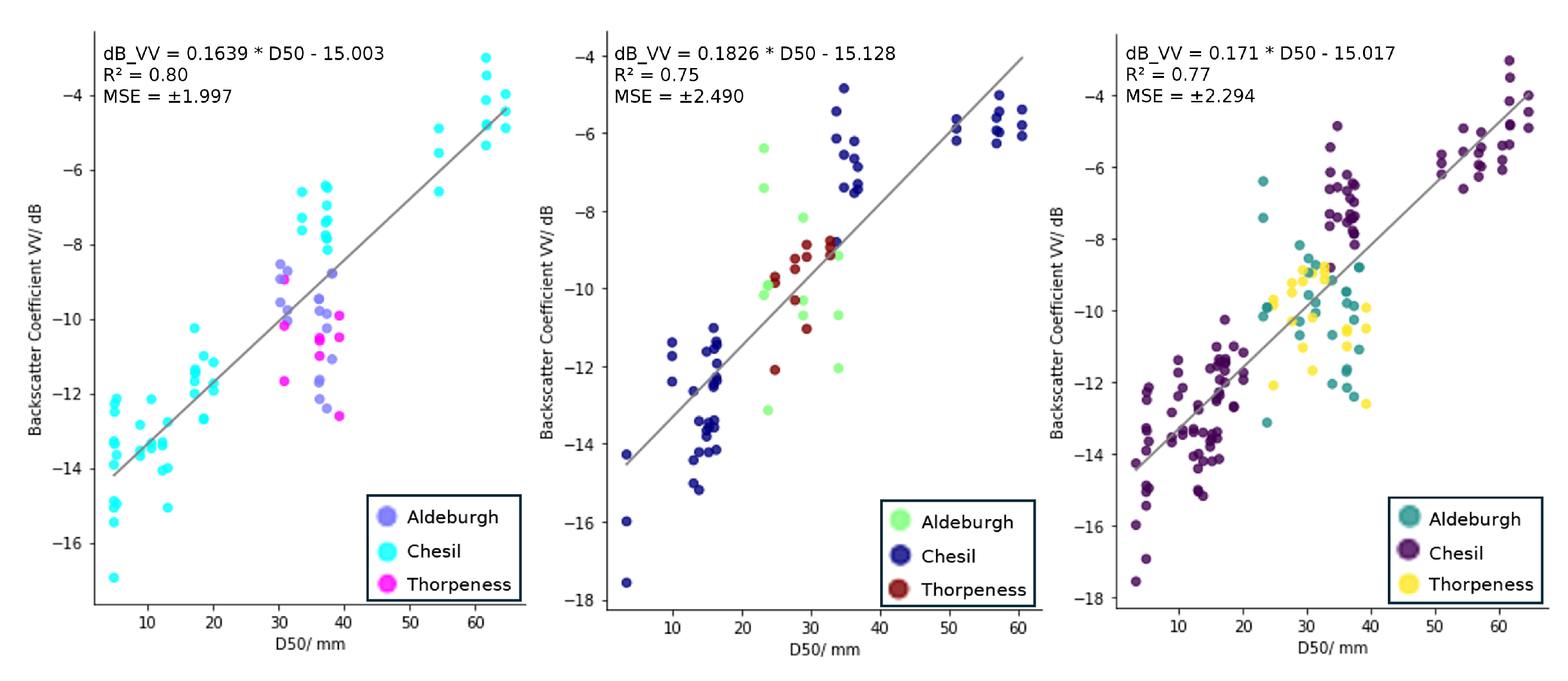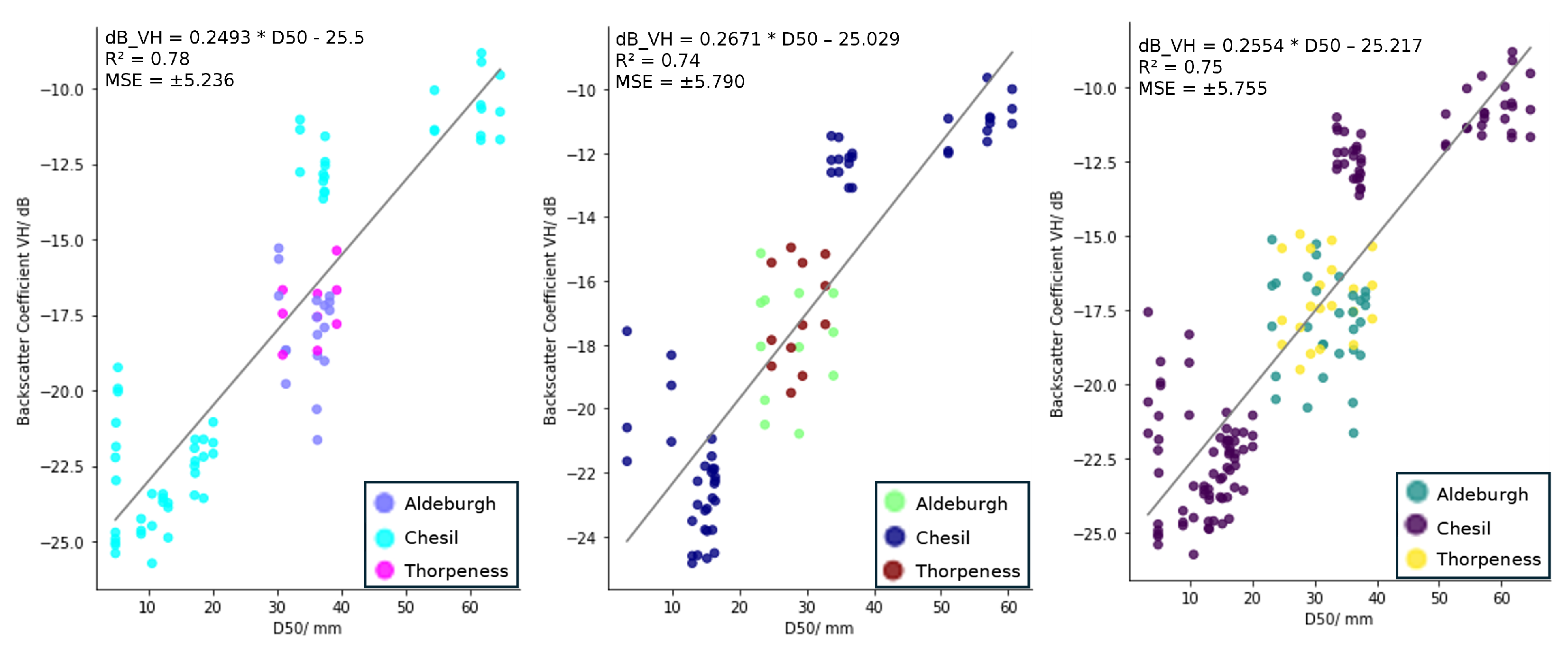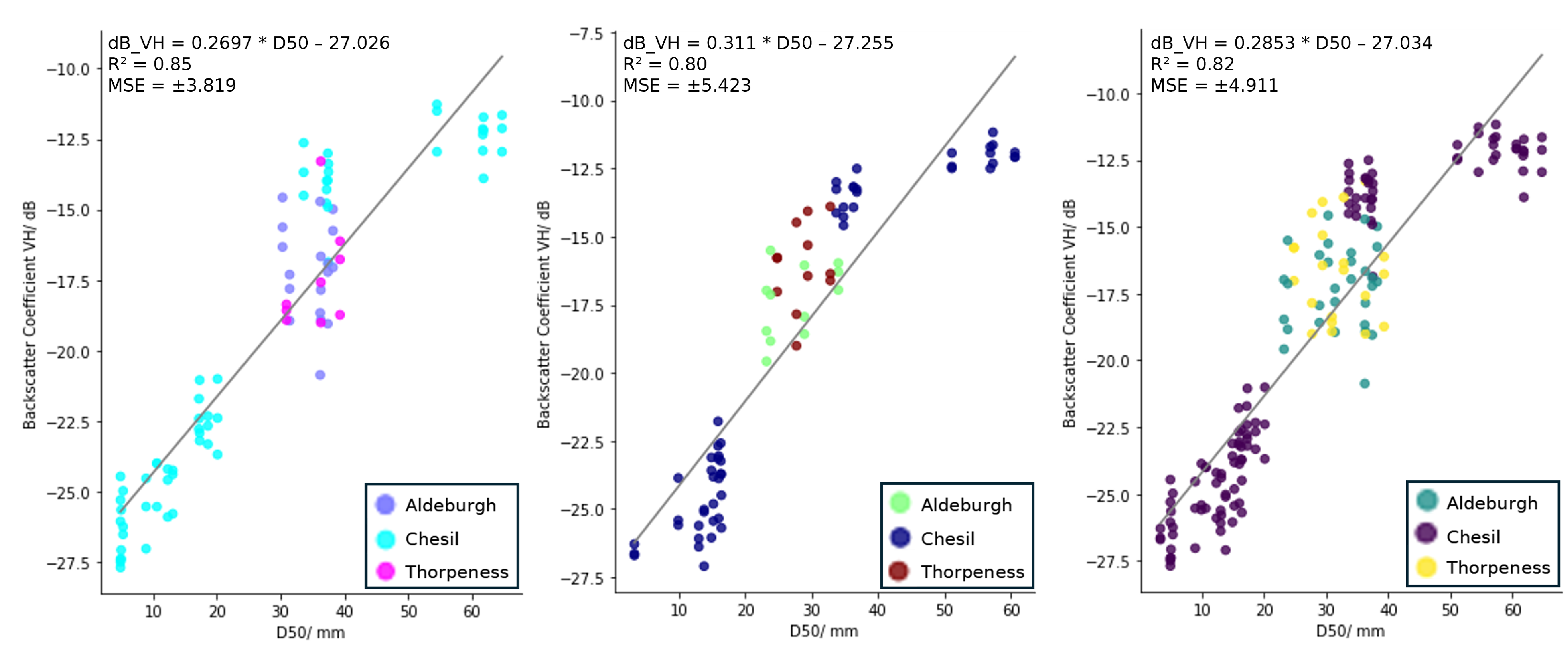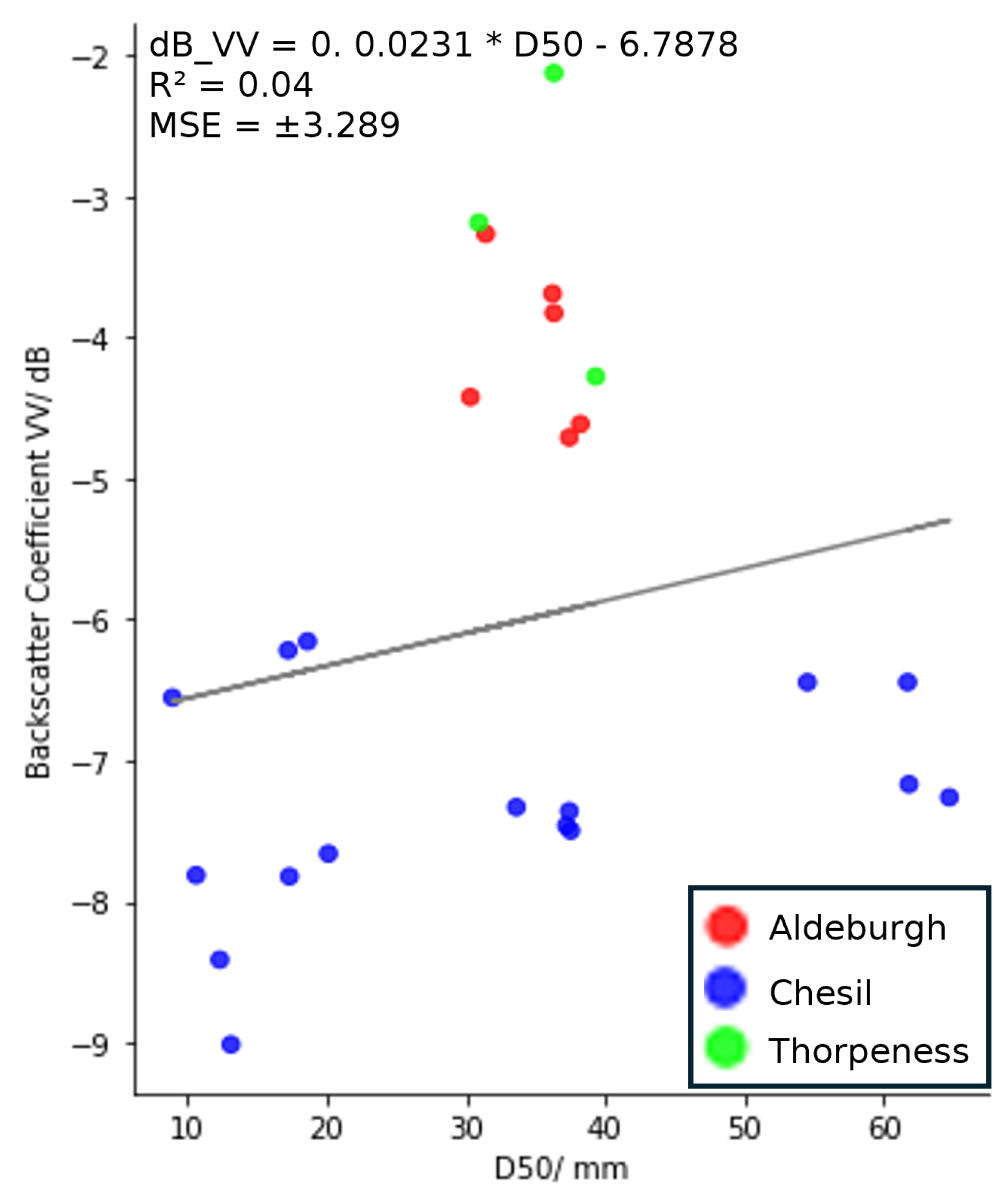Coastal Sediment Grain Size Estimates on Gravel Beaches Using Satellite Synthetic Aperture Radar (SAR)
Abstract
:1. Introduction
2. Materials and Methods
2.1. Study Area
2.2. Ground Truth Data
2.2.1. Grain Size Measurements
2.2.2. Beach Elevation Measurements
2.3. SAR Data Processing
3. Results
3.1. Variations in SAR Backscatter
3.2. Average Backscatter and D50
3.3. Predicting Grain Size
4. Discussion
4.1. Sediment Grain Size and Sentinel-1 C-Band SAR
4.1.1. Effects of Polarisation
4.1.2. Effects of Orbit Pass
4.1.3. Limits of Grain Size Derivation
4.2. Sediment Grain Size and NovaSAR S-Band SAR
4.3. Potential to Predict D50 from Sentinel-1 Backscatter
5. Conclusions
Author Contributions
Funding
Institutional Review Board Statement
Informed Consent Statement
Data Availability Statement
Acknowledgments
Conflicts of Interest
Appendix A
| Site | Satellite | Orbit Pass | Acquisition Date and Time | Field Survey Date |
|---|---|---|---|---|
| Aldeburgh Beach | Sentinel-1 | Ascending | 30 April 2022 17:41 | 13 May 2022 |
| Aldeburgh Beach | Sentinel-1 | Ascending | 24 May 2022 17:41 | 13 May 2022 |
| Aldeburgh Beach | Sentinel-1 | Ascending | 5 May 2022 17:41 | 13 May 2022 |
| Aldeburgh Beach | Sentinel 1 | Descending | 2 May 2022 06:14 | 13 May 2022 |
| Aldeburgh Beach | Sentinel-1 | Descending | 14 May 2022 06:14 | 13 May 2022 |
| Aldeburgh Beach | Sentinel-1 | Descending | 26 May 2022 06:15 | 13 May 2022 |
| Aldeburgh Beach | NovaSAR | Descending | 26 May 2022 09:33 | 13 May 2022 |
| Chesil Beach | Sentinel-1 | Ascending | 10 May 2022 17:57 | 23–25 May 2022 |
| Chesil Beach | Sentinel-1 | Ascending | 22 May 2022 17:57 | 23–25 May 2022 |
| Chesil Beach | Sentinel-1 | Ascending | 3 June 2022 17:57 | 23–25 May 2022 |
| Chesil Beach | Sentinel-1 | Descending | 7 May 2022 06:23 | 23–25 May 2022 |
| Chesil Beach | Sentinel-1 | Descending | 19 May 2022 06:23 | 23–25 May 2022 |
| Chesil Beach | Sentinel-1 | Descending | 31 May 2022 06:23 | 23–25 May 2022 |
| Chesil Beach | NovaSAR | Ascending | 31 May 2022 10:15 | 23–25 May 2022 |
| Thorpeness Beach | Sentinel-1 | Ascending | 30 April 2022 17:41 | 13 May 2022 |
| Thorpeness Beach | Sentinel-1 | Ascending | 24 May 2022 17:41 | 13 May 2022 |
| Thorpeness Beach | Sentinel-1 | Ascending | 5 May 2022 17:41 | 13 May 2022 |
| Thorpeness Beach | Sentinel 1 | Descending | 2 May 2022 06:14 | 13 May 2022 |
| Thorpeness Beach | Sentinel-1 | Descending | 14 May 2022 06:14 | 13 May 2022 |
| Thorpeness Beach | Sentinel-1 | Descending | 26 May 2022 06:15 | 13 May 2022 |
| Thorpeness Beach | NovaSAR | Descending | 26 May 2022 09:33 | 13 May 2022 |
| Weybourne Beach | Sentinel-1 | Ascending | 30 April 2022 17:41 | 31 May 2022 |
| Weybourne Beach | Sentinel-1 | Ascending | 24 May 2022 17:41 | 31 May 2022 |
| Weybourne Beach | Sentinel-1 | Ascending | 5 June 2022 17:42 | 31 May 2022 |
| Weybourne Beach | Sentinel-1 | Descending | 2 May 2022 06:14 | 31 May 2022 |
| Weybourne Beach | Sentinel-1 | Descending | 14 May 2022 06:14 | 31 May 2022 |
| Weybourne Beach | Sentinel-1 | Descending | 26 May 2022 06:14 | 31 May 2022 |
| Aldeburgh Beach | Sentinel-1 | Ascending | 7 May 2023 17:41 | 22 May 2023 |
| Aldeburgh Beach | Sentinel-1 | Ascending | 19 May 2023 17:41 | 22 May 2023 |
| Aldeburgh Beach | Sentinel-1 | Ascending | 31 May 2023 17:41 | 22 May 2023 |
| Aldeburgh Beach | Sentinel-1 | Descending | 9 May 2023 06:15 | 22 May 2023 |
| Aldeburgh Beach | Sentinel-1 | Descending | 21 May 2023 06:15 | 22 May 2023 |
| Aldeburgh Beach | Sentinel-1 | Descending | 2 June 2023 06:15 | 22 May 2023 |
| Chesil Beach | Sentinel-1 | Ascending | 5 May 2023 17:57 | 15–19 May 2023 |
| Chesil Beach | Sentinel-1 | Ascending | 17 May 2023 17:57 | 15–19 May 2023 |
| Chesil Beach | Sentinel-1 | Ascending | 29 May 23 17:57 | 15–19 May 2023 |
| Chesil Beach | Sentinel-1 | Descending | 2 May 2023 06:23 | 15–19 May 2023 |
| Chesil Beach | Sentinel-1 | Descending | 14 May 2023 06:23 | 15–19 May 2023 |
| Chesil Beach | Sentinel-1 | Descending | 26 May 2023 06:23 | 15–19 May 2023 |
| Thorpeness Beach | Sentinel-1 | Ascending | 7 May 2023 17:41 | 22 May 2023 |
| Thorpeness Beach | Sentinel-1 | Ascending | 19 May 2023 17:41 | 22 May 2023 |
| Thorpeness Beach | Sentinel-1 | Ascending | 31 May 2023 17:41 | 22 May 2023 |
| Thorpeness Beach | Sentinel-1 | Descending | 9 May 2023 06:15 | 22 May 2023 |
| Thorpeness Beach | Sentinel-1 | Descending | 21 May 2023 06:15 | 22 May 2023 |
| Thorpeness Beach | Sentinel-1 | Descending | 2 June 2023 06:15 | 22 May 2023 |
| Weybourne Beach | Sentinel-1 | Ascending | 7 May 2023 17:42 | 24 May 2023 |
| Weybourne Beach | Sentinel-1 | Ascending | 19 May 2023 17:42 | 24 May 2023 |
| Weybourne Beach | Sentinel-1 | Ascending | 31 May 2023 17:42 | 24 May 2023 |
| Weybourne Beach | Sentinel-1 | Descending | 9 May 2023 06:14 | 24 May 2023 |
| Weybourne Beach | Sentinel-1 | Descending | 21 May 2023 06:14 | 24 May 2023 |
| Weybourne Beach | Sentinel-1 | Descending | 2 June 2023 06:14 | 24 May 2023 |
References
- Cabezas-Rabadán, C.; Pardo-Pascual, J.E.; Palomar-Vázquez, J. Characterizing the relationship between the sediment grain size and the shoreline variability defined from sentinel-2 derived shorelines. Remote Sens. 2021, 13, 2829. [Google Scholar] [CrossRef]
- Bio, A.; Bastos, L.; Granja, H.; Pinho, J.L.S.; Gonçalves, J.A.; Henriques, R.; Madeira, S.; Magalhães, A.; Rodrigues, D. Methods for coastal monitoring and erosion risk assessment: Two Portuguese case studies. Rev. Gestão Costeira Integr. J. Integr. Coast. Zone Manag. 2015, 15, 47–63. [Google Scholar] [CrossRef]
- Chardon, V.; Schmitt, L.; Piégay, H.; Lague, D. Use of terrestrial photosieving and airborne topographic LiDAR to assess bed grain size in large rivers: A study on the Rhine River. Earth Surf. Process. Landforms 2020, 45, 2314–2330. [Google Scholar] [CrossRef]
- Yu, X.; Zhan, C.; Liu, Y.; Bi, J.; Li, G.; Cui, B.; Wang, L.; Liu, X.; Wang, Q. Retrieval of Remotely Sensed Sediment Grain Size Evolution Characteristics along the Southwest Coast of Laizhou Bay Based on Support Vector Machine Learning. J. Mar. Sci. Eng. 2022, 10, 968. [Google Scholar] [CrossRef]
- McAllister, E.; Payo, A.; Novellino, A.; Dolphin, T.; Medina-Lopez, E. Multispectral satellite imagery and machine learning for the extraction of shoreline indicators. Coast. Eng. 2022, 174, 104102. [Google Scholar] [CrossRef]
- Vitousek, S.; Buscombe, D.; Vos, K.; Barnard, P.L.; Ritchie, A.C.; Warrick, J.A. The future of coastal monitoring through satellite remote sensing. Camb. Prism. Coast. Futur. 2023, 1, 10. [Google Scholar] [CrossRef]
- Bartholdy, J.; Folving, S. Sediment classification and surface type mapping in the Danish Wadden Sea by remote sensing. Neth. J. Sea Res. 1986, 20, 337–345. [Google Scholar] [CrossRef]
- Deronde, B.; Kempeneers, P.; Forster, R.M. Imaging spectroscopy as a tool to study sediment characteristics on a tidal sandbank in the Westerschelde. Estuar. Coast. Shelf Sci. 2006, 69, 580–590. [Google Scholar] [CrossRef]
- Rainey, M.P.; Tyler, A.N.; Gilvear, D.J.; Bryant, R.G.; McDonald, P. Mapping intertidal estuarine sediment grain size distributions through airborne remote sensing. Remote Sens. Environ. 2003, 86, 480–490. [Google Scholar] [CrossRef]
- Blickensdörfer, L.; Schwieder, M.; Pflugmacher, D.; Nendel, C.; Erasmi, S.; Hostert, P. Mapping of crop types and crop sequences with combined time series of Sentinel-1, Sentinel-2 and Landsat 8 data for Germany. Remote Sens. Environ. 2022, 269, 112831. [Google Scholar] [CrossRef]
- Meyer, F.J.; McAlpin, D.B.; Gong, W.; Ajadi, O.; Arko, S.; Webley, P.W.; Dehn, J. Integrating SAR and derived products into operational volcano monitoring and decision support systems. ISPRS J. Photogramm. Remote Sens. 2015, 100, 106–117. [Google Scholar] [CrossRef]
- Novellino, A.; Pennington, C.; Leeming, K.; Taylor, S.; Alvarez, I.G.; McAllister, E.; Arnhardt, C.; Winson, A. Mapping landslides from space: A review. Landslides 2024, 21, 1041–1052. [Google Scholar] [CrossRef]
- Grimaldi, S.; Xu, J.; Li, Y.; Pauwels, V.R.; Walker, J.P. Flood mapping under vegetation using single SAR acquisitions. Remote Sens. Environ. 2020, 237, 111582. [Google Scholar] [CrossRef]
- Gaber, A.; Soliman, F.; Koch, M.; El-Baz, F. Using full-polarimetric SAR data to characterize the surface sediments in desert areas: A case study in El-Gallaba Plain, Egypt. Remote Sens. Environ. 2015, 162, 11–28. [Google Scholar] [CrossRef]
- Deroin, J.P. Potential of Sentinel 1 Satellites for Mapping Tidal Flats. Case Study of the Baie Des Veys (Normandy, France). In Proceedings of the IGARSS 2020—2020 IEEE International Geoscience and Remote Sens, Symposium, Virtual, 26 September 2020; pp. 5733–5736. [Google Scholar]
- Wu, L.; Tajima, Y.; Yamanaka, Y.; Shimozono, T.; Sato, S. Study on characteristics of SAR imagery around the coast for shoreline detection. Coast. Eng. J. 2019, 61, 152–170. [Google Scholar] [CrossRef]
- Brakenhoff, L.B.; Smit, Y.; Donker, J.J.; Ruessink, G. Tide-induced variability in beach surface moisture: Observations and modelling. Earth Surf. Process. Landf. 2019, 44, 317–330. [Google Scholar] [CrossRef]
- Van Der Wal, D.; Herman, P.M.; Wielemaker-van Den Dool, A. Characterisation of surface roughness and sediment texture of intertidal flats using ERS SAR imagery. Remote Sens. Environ. 2005, 98, 96–109. [Google Scholar] [CrossRef]
- Van Der Wal, D.; Herman, P.M. Regression-based synergy of optical, shortwave infrared and microwave remote sensing for monitoring the grain-size of intertidal sediments. Remote Sens. Environ. 2007, 111, 89–106. [Google Scholar] [CrossRef]
- Gade, M.; Melchionna, S.; Stelzer, K.; Kohlus, J. Multi-frequency SAR data help improving the monitoring of intertidal flats on the German North Sea coast. Estuar. Coast. Shelf Sci. 2014, 140, 32–42. [Google Scholar] [CrossRef]
- Gade, M.; Alpers, W.; Melsheimer, C.; Tanck, G. Classification of sediments on exposed tidal flats in the German Bight using multi-frequency radar data. Remote Sens. Environ. 2008, 112, 1603–1613. [Google Scholar] [CrossRef]
- Wentworth, C.K. A scale of grade and class terms for clastic sediments. J. Geol. 1922, 30, 377–392. [Google Scholar] [CrossRef]
- Neal, A.; Pontee, N.I.; Pye, K.; Richards, J. Internal structure of mixed-sand-and-gravel beach deposits revealed using ground-penetrating radar. Sedimentology 2002, 49, 789–804. [Google Scholar] [CrossRef]
- Wolman, M.G. A method of sampling coarse river-bed material. EOS Trans. Am. Geophys. Union 1954, 35, 951–956. [Google Scholar]
- Narra, P.; Coelho, C.; Fonseca, J. Sediment grain size variation along a cross-shore profile–representative d 50. J. Coast. Conserv. 2015, 19, 307–320. [Google Scholar] [CrossRef]
- IW GRD Resolutions. Available online: https://sentinel.esa.int/web/sentinel/technical-guides/sentinel-1-sar/products-algorithms/level-1-algorithms/ground-range-detected/iw (accessed on 24 April 2024).
- Novellino, A.; Mansour, M.; Wang, L. Measuring Soil Moisture with Spaceborne Synthetic Aperture Radar Data; Open Report; British Geological Survey: Nottingham, UK, 2020; 45p. [Google Scholar]
- NovaSAR-1 User Guide. Available online: https://research.csiro.au/cceo/novasar/novasar-introduction/novasar-1-user-guide/ (accessed on 3 April 2024).
- Natale, A.; Guida, R.; Bird, R.; Whittaker, P.; Cohen, M.; Hall, D. Demonstration and analysis of the applications of S-band SAR. In Proceedings of the 2011 3rd International Asia-Pacific Conference on Synthetic Aperture Radar (APSAR), Seoul, Republic of Korea, 26 September 2011; pp. 1–4. [Google Scholar]
- Iervolino, P.; Guida, R.; Whittaker, P. NovaSAR-S and maritime surveillance. In Proceedings of the 2013 IEEE International Geoscience and Remote Sens. Symposium-IGARSS, Melbourne, Australia, 21 July 2013; pp. 1282–1285. [Google Scholar]
- Saini, O.; Bhardwaj, A.; Chatterjee, R.S. Analysis of Back-Scattering Coefficient of NovaSAR-1 S-Band SAR datasets for different Land Covers. In Proceedings of the National Seminar on Recent Advances in Geospatial Technology & Applications, Dehradun, India, 2 March 2020. [Google Scholar]
- Gorelic, N.; Hancher, M.; Dixon, M.; Ilyushchenko, S.; Thau, D.; Moore, R. Google Earth Engine: Planetary-scale geospatial analysis for everyone. Remote Sens. Environ. 2017, 202, 18–27. [Google Scholar] [CrossRef]
- Sentinel-1 Algorithms. Available online: https://developers.google.com/earth-engine/guides/sentinel1 (accessed on 3 April 2024).
- Kabeya, K.K.; Legge, T.F.H. Relationship between grain size and some surface roughness parameters of rock joints. Int. J. Rock Mech. Min. Sci. 1997, 34, 146. [Google Scholar] [CrossRef]
- Ferrini, V.L.; Flood, R.D. The effects of fine-scale surface roughness and grain size on 300 kHz multibeam backscatter intensity in sandy marine sedimentary environments. Mar. Geol. 2006, 228, 153–172. [Google Scholar] [CrossRef]
- Runya, R.M.; McGonigle, C.; Quinn, R.; Howe, J.; Collier, J.; Fox, C.; Dooley, J.; O’loughlin, R.; Calvert, J.; Scott, L.; et al. Examining the links between multi-frequency multibeam backscatter data and sediment grain size. Remote Sens. 2021, 13, 1539. [Google Scholar] [CrossRef]










| Model | MAE (LOO) /mm | MAE (Weybourne) /mm | |
|---|---|---|---|
| VH descending 2022 | 0.85 | 5.17 | 5.47 |
| VH descending 2022 and 2023 | 0.82 | 5.56 | 4.66 |
| VV ascending 2022 | 0.80 | 6.40 | 5.26 |
| VH descending 2023 | 0.80 | 5.45 | 3.56 |
| VH ascending 2022 | 0.78 | 6.45 | 2.53 |
| VV ascending 2022 and 2023 | 0.77 | 6.41 | 4.30 |
| VV descending 2022 | 0.76 | 6.81 | 5.57 |
| VV ascending 2023 | 0.75 | 6.18 | 2.26 |
| VH ascending 2022 and 2023 | 0.75 | 6.52 | 5.42 |
| VH ascending 2023 | 0.74 | 6.33 | 7.41 |
| VV descending 2022 and 2023 | 0.67 | 6.78 | 5.52 |
| VV descending 2023 | 0.57 | 7.05 | 6.95 |
| Model | Equation of MLR Model | MAE (LOO) /mm | MAE (Weybourne) /mm | |
|---|---|---|---|---|
| VH/VV descending 2022 | D50 = 1.05 ∗ dB(VV) + 2.37 ∗ dB(VH) + 86.35 | 0.87 | 4.98 | 4.25 |
| VH/VV ascending 2022 | D50 = 2.94 ∗ dB(VV) + 1.38 ∗ dB(VH) + 84.32 | 0.83 | 6.04 | 3.22 |
| VH/VV descending 2022 and 2023 | D50 = 0.38 ∗ dB(VV) + 2.58 ∗ dB(VH) + 81.42 | 0.82 | 5.49 | 3.77 |
| VH/VV descending 2023 | D50 = −0.36 ∗ dB(VV) + 2.84 ∗ dB(VH) + 76.79 | 0.80 | 5.57 | 3.03 |
| VH/VV ascending 2022 and 2023 | D50 = 2.68 ∗ dB(VV) + 1.35 ∗ dB(VH) + 79.82 | 0.80 | 5.98 | 3.65 |
| VH/VV ascending 2023 | D50 = 2.36 ∗ dB(VV) + 1.35 ∗ dB(VH) + 75.31 | 0.79 | 5.79 | 3.43 |
Disclaimer/Publisher’s Note: The statements, opinions and data contained in all publications are solely those of the individual author(s) and contributor(s) and not of MDPI and/or the editor(s). MDPI and/or the editor(s) disclaim responsibility for any injury to people or property resulting from any ideas, methods, instructions or products referred to in the content. |
© 2024 by the authors. Licensee MDPI, Basel, Switzerland. This article is an open access article distributed under the terms and conditions of the Creative Commons Attribution (CC BY) license (https://creativecommons.org/licenses/by/4.0/).
Share and Cite
Mann, S.; Novellino, A.; Hussain, E.; Grebby, S.; Bateson, L.; Capsey, A.; Marsh, S. Coastal Sediment Grain Size Estimates on Gravel Beaches Using Satellite Synthetic Aperture Radar (SAR). Remote Sens. 2024, 16, 1763. https://doi.org/10.3390/rs16101763
Mann S, Novellino A, Hussain E, Grebby S, Bateson L, Capsey A, Marsh S. Coastal Sediment Grain Size Estimates on Gravel Beaches Using Satellite Synthetic Aperture Radar (SAR). Remote Sensing. 2024; 16(10):1763. https://doi.org/10.3390/rs16101763
Chicago/Turabian StyleMann, Sophie, Alessandro Novellino, Ekbal Hussain, Stephen Grebby, Luke Bateson, Austin Capsey, and Stuart Marsh. 2024. "Coastal Sediment Grain Size Estimates on Gravel Beaches Using Satellite Synthetic Aperture Radar (SAR)" Remote Sensing 16, no. 10: 1763. https://doi.org/10.3390/rs16101763
APA StyleMann, S., Novellino, A., Hussain, E., Grebby, S., Bateson, L., Capsey, A., & Marsh, S. (2024). Coastal Sediment Grain Size Estimates on Gravel Beaches Using Satellite Synthetic Aperture Radar (SAR). Remote Sensing, 16(10), 1763. https://doi.org/10.3390/rs16101763







